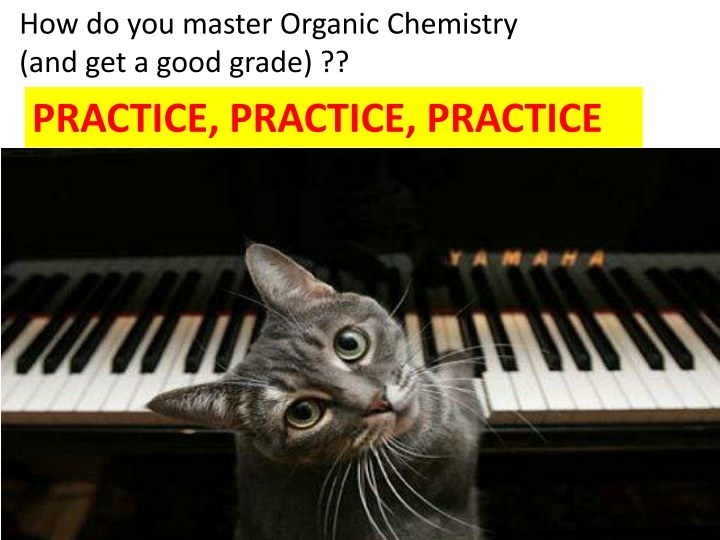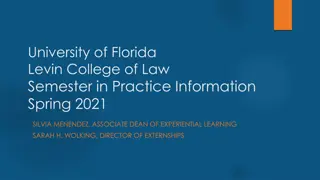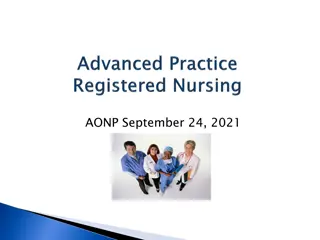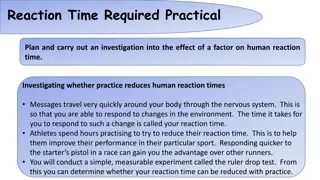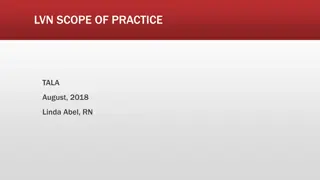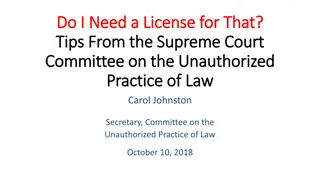PRACTICE, PRACTICE, PRACTICE
To excel in Organic Chemistry, practice is key. Familiarize yourself with reactions of alkenes, understand different classes of reactions, and recognize key characteristics and mechanisms. Regular practice and drills can help you grasp concepts effectively and achieve a good grade.
Download Presentation

Please find below an Image/Link to download the presentation.
The content on the website is provided AS IS for your information and personal use only. It may not be sold, licensed, or shared on other websites without obtaining consent from the author.If you encounter any issues during the download, it is possible that the publisher has removed the file from their server.
You are allowed to download the files provided on this website for personal or commercial use, subject to the condition that they are used lawfully. All files are the property of their respective owners.
The content on the website is provided AS IS for your information and personal use only. It may not be sold, licensed, or shared on other websites without obtaining consent from the author.
E N D
Presentation Transcript
How do you master Organic Chemistry (and get a good grade) ?? PRACTICE, PRACTICE, PRACTICE
Drill and practice with reactions of alkenes (the re-run) The 4 main classes of reactions of alkene are: (U-Pick) a) elimination, substitution, allylic addition, rearrangement b) SN1, SN2, E1 and E2 c) Carbocation addition, bridgehead addition, free radical addition and organometallic/redox reactions d) Radical substitution, SN1, E2 and allylic rearrangement In a carbocation addition, addition proceeds: a) To make rearranged alkene b) Anti-Markovnikoff, inverted c) Markovnikoff, inverted d) Markovnikoff, racemic Which class of reactions of alkenes always involves Br2 in CCl4 or ether ?Bridgehead (halohydrin) mechanism
Free radical additions are characterized by: a) Absence of peroxides and markovnikoff addition b) Formation of rings and unsaturated produces c) Presence of peroxides and markovnikoff substitution d) Presence of peroxides and anti-markovnikoff substitution Key intermediate state in halohydrin reactions : a) Sp2 Carbocation b) Free radical c) 3-atom semi-carbocation d) 5-coordinate complex Which reaction class(es) can produce larger dimers, trimers polymers c) radical d) carbocation b) Organometallic /redox a) bridgehead Which reaction class includes reactions that aren t additions ? Organometallic (ozonolysis and allylic substitutions)
Term Anti addition Reaction class Bridgehead (halohydrin) Anti Markovnikoff addition Radical addition Syn and anti; H.C. Brown, peroxy acids and NBS Organometallic/redox Dimers and trimers; industrial route to ethanol carbocation Polymerization; carbene insertion; freon additions Radical addition carbocation Markovnikoff addition
CCl4 wet OH + Br2 Br H+/reflux OH + H2O Hg(OAc)2 in THF NaBH4 /OH- OH >95% yield 100% Mark.
Product name ? OH OH cold KMnO4 Syn diol H peroxide, HBr in acetic acid Br peroxide/ light Etc
Br ethanol + KOH + major minor Run an ozonolysis O Zn/H+ O3 O Run the anti-Markovnikoff Brown 2 step preparation of alcohols H B2H6 neat H2O2 with OH- OH
http://s2.quickmeme.com/img/e3/e34cccb03ba9f04ee1c92adb03404096aa0ef2480208f7a42d97b2a7c8c15691.jpghttp://s2.quickmeme.com/img/e3/e34cccb03ba9f04ee1c92adb03404096aa0ef2480208f7a42d97b2a7c8c15691.jpg Final question .
